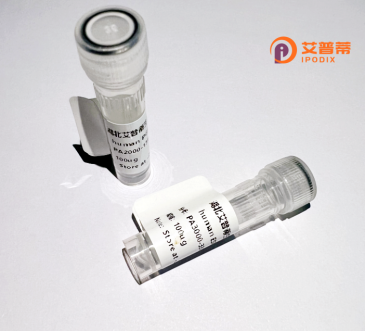
| 纯度 | >90%SDS-PAGE. |
| 种属 | Human |
| 靶点 | Shh |
| Uniprot No | Q15465 |
| 内毒素 | < 0.01EU/μg |
| 表达宿主 | E.coli |
| 表达区间 | 24-197aa |
| 氨基酸序列 | CGPGRGFGKRRHPKKLTPLAYKQFIPNVAEKTLGASGRYEGKISRNSERF KELTPNYNPDIIFKDEENTGADRLMTQRCKDKLNALAISVMNQWPGVKLR VTEGWDEDGHHSEESLHYEGRAVDITTSDRDRSKYGMLARLAVEAGFDWV YYESKAHIHCSVKAENSVAAKSGG |
| 预测分子量 | 51 kDa |
| 蛋白标签 | His tag N-Terminus |
| 缓冲液 | PBS, pH7.4, containing 0.01% SKL, 1mM DTT, 5% Trehalose and Proclin300. |
| 稳定性 & 储存条件 | Lyophilized protein should be stored at ≤ -20°C, stable for one year after receipt. Reconstituted protein solution can be stored at 2-8°C for 2-7 days. Aliquots of reconstituted samples are stable at ≤ -20°C for 3 months. |
| 复溶 | Always centrifuge tubes before opening.Do not mix by vortex or pipetting. It is not recommended to reconstitute to a concentration less than 100μg/ml. Dissolve the lyophilized protein in distilled water. Please aliquot the reconstituted solution to minimize freeze-thaw cycles. |
以下是关于Shh重组蛋白的3篇代表性文献及其摘要概括:
---
1. **"Sonic hedgehog mediates the polarizing activity of the ZPA" (Cell, 1993)**
- **作者**: Echelard et al.
- **摘要**: 首次报道重组Shh蛋白在胚胎发育中的极性活性,证实其可模拟鸡胚肢芽中ZPA(极性活性区)的信号功能,为Shh在模式形成中的关键作用提供证据。
2. **"Purification and functional analysis of recombinant Sonic Hedgehog protein" (JBC, 1994)**
- **作者**: Lee et al.
- **摘要**: 描述通过哺乳动物细胞表达系统高效纯化重组Shh蛋白的方法,并验证其生物活性(如诱导神经管细胞分化),为后续功能研究提供标准化流程。
3. **"Recombinant Shh enhances neuronal differentiation in neural stem cells" (Development, 2002)**
- **作者**: Lai et al.
- **摘要**: 证明重组Shh蛋白通过激活Gli1通路促进神经干细胞向多巴胺能神经元分化,为神经退行性疾病治疗提供体外模型基础。
---
如需更多文献或具体应用场景(如癌症、药物筛选),可进一步补充说明。
**Background of Recombinant Shh Protein**
Sonic Hedgehog (Shh) is a secreted glycoprotein central to developmental signaling pathways, playing a critical role in embryonic patterning, cell differentiation, and tissue homeostasis. As a key member of the Hedgehog (Hh) protein family, Shh regulates morphogenesis by binding to the Patched (Ptch) receptor, relieving suppression of the Smoothened (Smo) protein, and activating downstream transcription factors (e.g., Gli family). This signaling cascade governs processes such as neural tube formation, limb development, and organogenesis.
Recombinant Shh protein is engineered using biotechnological methods to mimic the native protein’s functional properties. It is typically produced in heterologous expression systems (e.g., mammalian cells, *E. coli*, or insect cells) to ensure proper post-translational modifications, solubility, and bioactivity. The recombinant form retains the ability to bind receptors and activate signaling, making it indispensable for *in vitro* and *in vivo* studies.
Research applications of recombinant Shh span developmental biology, regenerative medicine, and disease modeling. It is widely used to study tissue repair, stem cell differentiation (e.g., neural or pancreatic progenitors), and cancer biology, as dysregulated Shh signaling is implicated in malignancies like medulloblastoma and basal cell carcinoma. Additionally, it serves as a therapeutic candidate for neurodegenerative disorders or injuries, promoting neuronal survival and axonal growth.
The production of recombinant Shh addresses challenges associated with isolating the native protein, offering scalability, consistency, and reduced batch-to-batch variability. Its versatility continues to drive innovations in drug discovery and biomedical engineering, underscoring its significance in both basic research and translational applications.
×